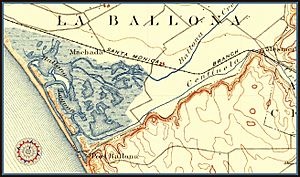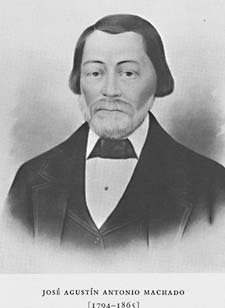Rancho La Ballona facts for kids
Rancho La Ballona was a huge piece of land, about 13,920 acres (56 square kilometers), in what is now the Westside area of Los Angeles County, Southern California. It was a Mexican land grant, which means the Mexican government gave this land to people.
The rancho was officially given to Ygnacio and Augustin Machado, and Felipe and Tomas Talamantes in 1839. This was confirmed by Alta California Governor Juan Alvarado. However, these families had already been allowed to use the land to graze their cattle since 1819, when Spain still controlled the area. Many members of the Machado and Talamantes families from the late 1800s and early 1900s are buried in a cemetery that used to be on the rancho's northern edge. This cemetery is now known as the Woodlawn Cemetery of Santa Monica.
The land grant stretched from inland areas, near today's San Diego Freeway, all the way to Santa Monica Bay. It included parts of what are now Mar Vista, Westside Village, Palms, and Culver City. It also went northwest to Pico Boulevard and the Ocean Park area of Santa Monica. To the south, it followed Ballona Creek through Venice, the Ballona Wetlands, and modern-day Marina del Rey, Playa Vista, and Playa Del Rey.
Contents
History of Rancho La Ballona
The Rancho La Ballona land stretched from the ocean into areas like Mar Vista, Westside Village, Palms, and Culver City. It also went north to Pico Boulevard in Santa Monica and south to Playa Del Rey.
In 1819, Augustin Machado and Felipe Talamantes first received a permit to use land called Rancho de Los Quintos in Santa Barbara. But this land did not turn out to be very useful for them.
So, in 1821, they applied again for new land. This time, Augustin's brother Ygnacio and Felipe's son Tomas joined them. The military commander, José de la Guerra y Noriega, gave them permission to graze their cattle on the lands that would become Rancho La Ballona. At that time, they were living in the Pueblo de Los Ángeles, which is now the city of Los Angeles. In 1839, the Mexican Governor Alvarado officially gave them the land grant for Rancho La Ballona.

A small settlement called Port Ballona was located on the rancho, right at the mouth of Ballona Creek.
After the Mexican–American War, California became part of the United States. The 1848 Treaty of Guadalupe Hidalgo promised that the land grants given by Mexico would still be valid. So, in 1851, the US passed the Land Act. This law required people to register their land claims. The Machados and Talamanteses registered their claim for Rancho La Ballona with the Board of California Land Commissioners. Their claim was approved in 1854.
The US District Court also agreed with the decision in 1873. This was 8 years after Agustín Machado had passed away. Finally, Rancho La Ballona was officially given to the original four claimants, covering 13,920 acres.
In 1857, a man named Benjamin D. Wilson received ownership of one-fourth of Rancho La Ballona. He got it because Tomas Talamantes could not pay back a loan Wilson had given him. Wilson then sold his part of the rancho to George A. Sanford and John D. Young. In 1863, they asked for the lower Ballona Valley land to be divided. In 1868, a plan was made to divide it into 23 sections. Each of these long, narrow sections had three types of land: "pasture" for animals, "irrigable" for farming, and "bay" land near Santa Monica Bay. The largest part of the rancho, on the bluff northwest of Ballona Valley, went to the "Estate of Augustin Machado." Later, in 1875, this part was divided among Augustin Machado's family.
Camp Latham During the Civil War
During the American Civil War, General George Wright ordered soldiers to protect Port Ballona. This was to prevent people who supported the Confederates from taking control of the port. By 1862, about 6,000 Union troops were stationed at Port Ballona. Their military base was named Camp Latham, after a person named Milton Latham.
The Machado Family
José Manuel Machado (1756–1810) married María de la Luz Valenzuela Y Avilas in 1780. He traveled with an expedition to Alta California in 1781. Later that year, Machado retired to the Pueblo de Los Angeles. Two of his sons, José Agustín Antonio Machado and José Ygnacio Antonio Machado, tried for a long time to get permission to graze animals on land near the pueblo.
Agustín Machado (1794–1865)
Agustín Machado married María Petra Buelna in 1824. Sadly, she passed away while giving birth to their first child, Juan Bautista (1826–1907). In 1827, Machado married Ramona Sepúlveda. She was the daughter of Francisco Sepulveda. Agustín and Ramona had 14 children together.
Agustín Machado was a successful rancher. In 1855, he bought the Rancho Santa Rosa from Juan Moreno. Later, in 1858, he also bought the nearby Rancho La Laguna from Abel Stearns. This rancho was also a stop for the Butterfield Overland Mail stagecoach service until 1861.
- Francisco Machado, one of Agustín Machado's sons, served as a Los Angeles County Supervisor for two terms. He was elected in 1872 and again in 1874. A lake in Harbor City was named Lake Machado in his honor.
Ygnacio Machado (1797–1878)
In 1826, Ygnacio Machado married Estefana Palomares. They had seven children. Ygnacio Machado was given the land grant for Rancho Aguaje de la Centinela in 1837. In 1845, Machado traded this rancho to Bruno Avila for a smaller piece of land in the Pueblo of Los Angeles.
The Talamantes Family
Felipe Talamantes (1771–1856)
Luis Felipe Talamantes was a retired soldier. Between 1783 and 1784, he worked as a manager for Rancho San Pedro with Juan Jose Dominguez. He went back to Baja California to get married in 1792. Felipe brought his wife, Idlefonza Avila, and their son Tomas back to the Pueblo of Los Angeles in 1794. Felipe and Idlefonza had several children, including Tomas, Pablo Antonio, Maria de Los Angeles, Felipe, and Jose Nicodemus.
Tomás Talamantes (1792–1873)
Tomas Talamantes married Maria Petronila Olivas, and they had eight children. In 1857, he lost his one-fourth share of Rancho La Ballona because he could not pay back a loan.



